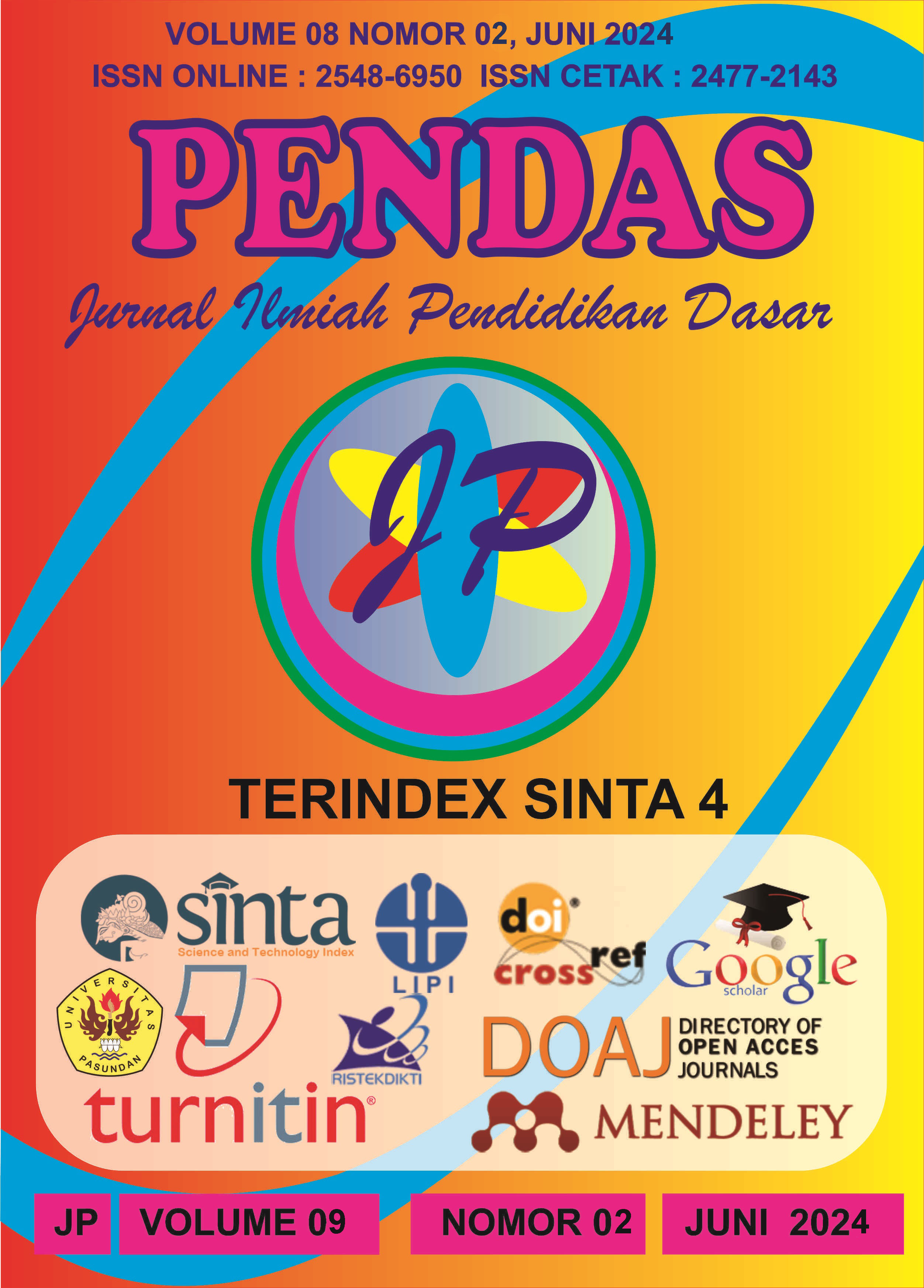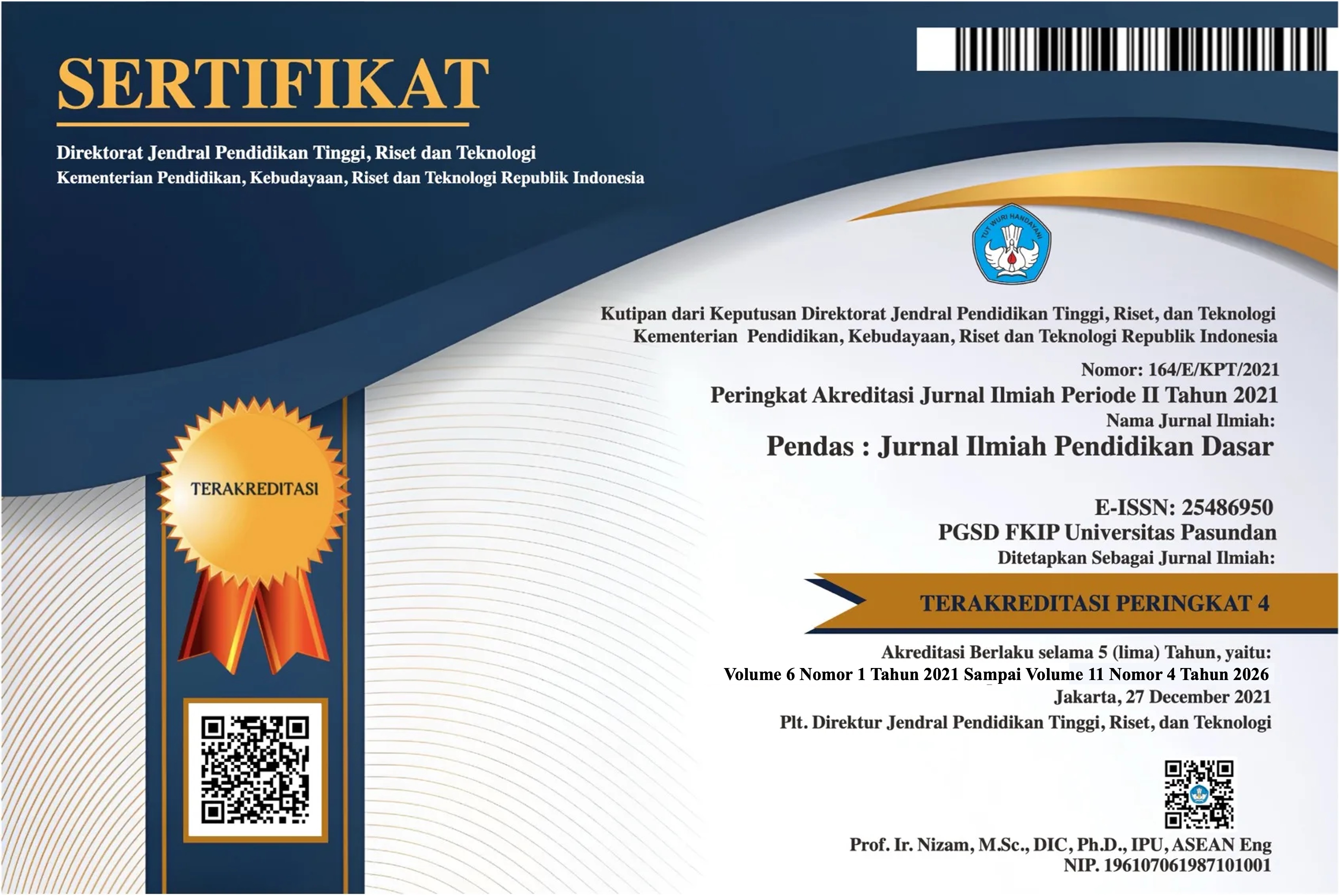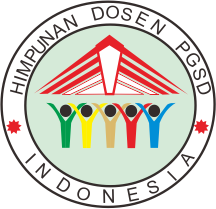PENGGUNAAN CANVA SEBAGAI MEDIA INTERAKTIF DALAM MENINGKATKAN KETERAMPILAN BERPIKIR KRITIS PADA PEMBELAJARAN PENDIDIKAN PANCASILA UNTUK SISWA SD KELAS IV
DOI:
https://doi.org/10.23969/jp.v9i2.14117Keywords:
canva, interactive media, critical thinking skillsAbstract
The aim of this study is to create and evaluate how Canva, as an interactive media, can help elementary school students (SD) improve their critical thinking skills while learning about Pancasila Education. Canva is a user-friendly graphic design platform designed to present innovative and engaging educational content. The Research and Development (R&D) approach uses the ADDIE model (Analysis, Design, Development, Implementation, Evaluation). Fourth-grade elementary school students in Sidoarjo were the subjects of this research. During the analysis stage, assessments and surveys of teachers and students identified the need for interactive learning media. The design process included creating a prototype of teaching materials using Canva. The development stage consisted of several trials and revisions made by users. Implementation was carried out by integrating Canva-based materials into different learning sessions. Critical thinking skills tests and observations of student behavior during learning were part of the final evaluation.The research results showed that the use of Canva significantly improved students' critical thinking skills, as indicated by better test scores for analysis, synthesis, and evaluation. Students were more active and motivated during the learning process, according to observations. Teachers reported that Canva helped make abstract concepts of Pancasila easier to understand and more engaging. The conclusion of this study suggests that elementary school students can enhance their critical thinking skills by using Canva-based learning media. Further research is needed to test other interactive media applications and to evaluate the long-term impact of using Canva in education.Downloads
References
Anam, C., Churiyah, M., & Pratama, N. Z. (2023). Improving Learning Outcomes and Self-Regulated Learning Through the Development of Web-Based Learning Media with Canva Platform. International Journal of Multicultural and Multireligious Understanding, 10(5), 376. https://doi.org/10.18415/ijmmu.v10i5.4820
Calvin, Y., Mali, G., Kurniawan, D., Januardi, J. I., Swara, S. J., Christy, N., Lokollo, E., Picauly, I. A., Paramitha, N. G., Argo Tanore, J., Dewani, M. S., & Pakiding, R. W. (2023). Issues and challenges of technology use in indonesian schools: implications for teaching and learning. IJIET (International Journal of Indonesian Education and Teaching), 7(2), 221–233. https://doi.org/10.24071/IJIET.V7I2.6310
Daud Yahya, M., Budi Susilo, C., Mayadiana Suwarma, D., Veza, O., Studi Sarjana Terapan Keperawatan Anestesiologi, P., Keperawatan, F., & Studi Pendidikan Guru Sekolah Dasar, P. (2023). Hubungan Penggunaan Multimedia dalam Pembelajaran terhadap Peningkatan Hasil Belajar Peserta Didik. Journal on Education, 6(1), 25–34. https://doi.org/10.31004/JOE.V6I1.2910
Dogani, B. (2023). Active learning and effective teaching strategies. International Journal of Advanced Natural Sciences and Engineering Researches, 7(4), 136–142. https://doi.org/10.59287/IJANSER.578
Hambali, H., Rozi, F., & Mardiya, M. (2023). Technology in education; tpack as an approach to becoming a revolutionary teacher in the digital age. Academy of Education Journal: Jurnal Ilmu-ilmu Kependidikan, 14(2), 171–185. https://doi.org/10.47200/AOEJ.V14I2.1646
Hanum*, L., Hasan, M., Pada, A. U. T., Rahmatan, H., Rahmayani, R. F. I., Elisa, E., & Yusrizal, Y. (2023). Development of Learning Devices Based on Ethnoscience Project Based Learning to Improve Students’ Critical Thinking Skills. Jurnal pendidikan sains Indonesia, 11(2), 288–305. https://doi.org/10.24815/JPSI.V11I2.28294
Hasnawati, H. (2023). Analysis of Learning Design Using The Canva Application in Information and Communication Technology (ICT)Training. 12 Waiheru, 9(1), 75–81. https://doi.org/10.47655/12WAIHERU.V9I1.143
Hudjolly, S. N., & Dewi, R. S. (2023). Pancasila Ideology in Political Education Programs. AURELIA: Jurnal Penelitian dan Pengabdian Masyarakat Indonesia, 2(2), 793–796. https://doi.org/10.57235/AURELIA.V2I2.730
Juliarti, E. (2022). Development of Canva-Based Digital Teaching Materials to Train Students’ Understanding of Dynamic Fluid Concepts. IJOEM : Indonesian Journal of E-learning and Multimedia, 1(2), 73–77. https://doi.org/10.58723/IJOEM.V1I2.52
Kaltsas, E. P., & Gkaintartzi, A. (2023). Active Participation of Students in the Education Process. Research Highlights in Language, Literature and Education Vol. 6, 36–43. https://doi.org/10.9734/BPI/RHLLE/V6/9919F
Katona, B., Venkataragavan, J., Nina, E., Ulrika, B., & Björn, O. (2023). Use of Visual Learning Media to Increase Student Learning Motivation. World Psychology, 1(3), 89–105. https://doi.org/10.55849/WP.V1I3.381
Mahmudi, M. R., Darniyanti, Y., & Oktaviani, A. (2023). Pengembangan modul ajar berbantukan canva pada mata pelajaran ipas dalam kurikulum merdeka kelas iv sekolah dasar. Didaktik: Jurnal Ilmiah PGSD STKIP Subang, 9(2), 4910–4921. https://doi.org/10.36989/DIDAKTIK.V9I2.1289
Mishra, N. R. (2023). Constructivist Approach to Learning: An Analysis of Pedagogical Models of Social Constructivist Learning Theory. Journal of research and development, 6(01), 22–29. https://doi.org/10.3126/JRDN.V6I01.55227
Pappa, C. I., Georgiou, D., & Pittich, D. (2023). Technology education in primary schools: addressing teachers’ perceptions, perceived barriers, and needs. International Journal of Technology and Design Education, 34(2), 1–19. https://doi.org/10.1007/S10798-023-09828-8
Pradana, H. D., & Kristanto, A. (2022). Fostering Students’ Independent Learning in Introduction to Learning Media Courses through the Use of Interactive Multimedia. Teknodika, 20(1), 35–35. https://doi.org/10.20961/TEKNODIKA.V20I1.58626
Puspita, R. D., Wardani, D. S., & Rabbani, S. (2023). Development of teaching materials to improve reading comprehension skills for 5th grade students: canva app supported. JMIE (Journal of Madrasah Ibtidaiyah Education), 6(2), 163–163. https://doi.org/10.32934/JMIE.V6I2.442
Sartika, R., Praja, W. N., & Azis, A. (2022). Sustainable development goals: Recognition of Pancasila education materials in shaping student ethics in the digital era. Jurnal Civics: Media Kajian Kewarganegaraan, 19(2), 303–309. https://doi.org/10.21831/JC.V19I2.48285
Sofiana, N., Mubarok, H., Kristina, D., & Rochsantiningsih, D. (2022). Activities Based Contextual and Constructivist Learning: A Model for Enhancing Students’ English Learning Outcomes. KnE Social Sciences. https://doi.org/10.18502/KSS.V7I19.12467
Sri Septiarini, D., Heryadi, D., Chandra, D., & PGSD Fakultas Keguruan dan Ilmu Pendidikan Universitas Perjuangan Tasikmalaya, P. (2023). Penerapan media pembelajaran berbasis audio visual canva untuk meningkatkan keterampilan menulis puisi. JS (JURNAL SEKOLAH), 7(3), 498–498. https://doi.org/10.24114/JS.V7I3.45930
Suripto, S., Fabirah, N. R., Nanna, A. W. I., & Bua, M. T. (2023). Science, technology, engineering, and mathematics (stem) in exploring students’ critical thinking skills. Jurnal Aksioma, 12(1), 319–319. https://doi.org/10.24127/AJPM.V12I1.6044
Urumov, Z. E., Bigaeva, I. M., & Agaeva, F. A. (2023). The Canva Platform: Its Essence and the Possibility of Using in the Educational Process. Vestnik Severo-Osetinskogo gosudarstvennogo universiteta im. K.L. Hetagurova, 2, 120–128. https://doi.org/10.29025/1994-7720-2023-2-120-128
Waite-Stupiansky, S. (2022). Jean Piaget’s Constructivist Theory of Learning. Theories of Early Childhood Education: Developmental, Behaviorist, and Critical, 3–18. https://doi.org/10.4324/9781003288077-2
Widarti, H. R., Triwidiastuti, D., & Rokhim, D. A. (2022). Profile of Interactive Learning Media Based Digital Literacy Needs on Elemental Chemistry Concepts. JTK (Jurnal Tadris Kimiya), 7(2), 277–286. https://doi.org/10.15575/JTK.V7I2.20921
Downloads
Published
Issue
Section
License
Copyright (c) 2024 Pendas : Jurnal Ilmiah Pendidikan Dasar

This work is licensed under a Creative Commons Attribution 4.0 International License.



















